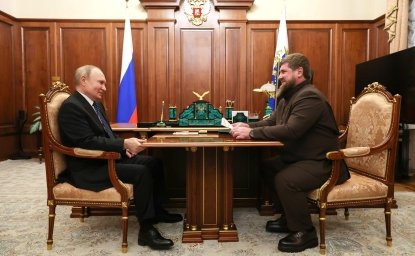
A blog of the Kennan Institute
An ongoing discussion has emerged in the media, in opinion pages, and at academic conferences over the extent to which Western sanctions have damaged the Russian economy. Perspectives vary according to whether long-term or short-term impacts are under discussion, the interlocutors’ reliance on internationally accepted economic principles or Russian financial magical thinking, and contrasting definitions of success.
Such analysis often lacks any insight into what Vladimir Putin and those around him think is going on. As happens with all of us, Putin’s views will have been shaped by his own experiences. His memory of the Soviet economic collapse, like his stated evaluation of the collapse of the Soviet Union, may find more fault with market-oriented reforms than with centralized planning practice. Before scoffing at this idea, it is important to recall Putin’s background in Leningrad, which may have given him an unexpectedly rosy portrait of the Soviet economy.
Putin’s Formative Years in Leningrad
While Putin has been and remains the preeminent figure in today’s authoritarian Russia—to the point that the current war in Ukraine is unimaginable without him—we should remember that he is very much the product of his past. Usually such a thought leads immediately to his years as a KGB officer. His Leningrad youth and coming-of-age experiences may offer further insight into how he thinks about Russian economic performance. Strikingly, such a shift in focus suggests that the “Putin system” is likely to survive him for longer than Western analysts might anticipate.
Putin grew up in a city that had long been in the grip of one of the most conservative Communist Party organizations in the Soviet Union. He attended Leningrad State University’s Juridical Faculty precisely at a moment in the mid-1970s when all but the most hardline professors were being forced out. He later served as head of the university’s foreign department, charged with enforcing boundaries between the university community and international colleagues. When he returned to the city as deputy mayor under Anatoli Sobchak, he found himself in a local bureaucracy dominated by Soviet apparatchiks with only a small circle of reformers at the top.
Perhaps most important for the young Putin, Leningrad had developed from the 1950s until the 1990s under successive leaders who embraced economic strategies counter to various market-oriented reforms. As I chronicled in my 1990 book, Leningrad: Shaping a Soviet City, this “Leningrad approach” favored strong centralized planning, the redistribution of resources away from light industry and services and toward favored high-technology and defense sectors, and the elevation of political authorities to superior positions over economic managers. Leningrad leaders remained more tied to older Soviet approaches to management for longer than many regional elites elsewhere.
As important for the young Putin, perhaps, local leaders viewed their strategies as having been successful, at least more successful than what they saw happening in Moscow. Throughout the years between the mid-1950s and the mid-1980s, Leningrad city and region achieved respectable rates of economic growth by Soviet standards and proved adept at promoting in-system innovations that allowed for necessary adjustments along the way. This must have seemed a heady period for the young Putin.
We know, of course, that these local policies failed to address the city’s long-term economic liabilities. They did not deal with the city’s peripheral geographic location, hard climate, lack of resources, and absence of an active hinterland. Nor could they offset the national economic collapse that was spinning out of control as international oil prices plummeted throughout the late 1980s. Market forces in the 1990s and 2000s proved more effective at repositioning the city for subsequent growth. Putin, however, undoubtedly retained a sense that the old Leningrad approach had been a success.
The Long Tail of the Leningrad Approach
At the end of the day, general economic laws will prove more meaningful than recollections of a golden era that never existed. Russia, like the Soviet Union, cannot run up a down economic escalator forever. Russian leaders nonetheless are likely to make policy choices based on personal experience rather than on economic theory.
The Leningrad approach that produced Vladimir Putin in the first instance also attaches a positive note to otherwise discredited political economic strategies. Putin and those around him can convince themselves of the efficaciousness of Soviet economic practices precisely because they experienced them a time when those practices could claim success.
My book about Leningrad’s autocratic vision of economic and urban management appeared at a moment when the city stopped being either Leningrad or Soviet. Notions of a comprehensive state-dominated economic strategy seemed irrelevant to the city’s—and Russia’s—future. Such thinking has proven premature. The Leningrad approach lives on in the person of Vladimir Putin.
The opinions expressed in this article are those solely of the author and do not reflect the views of the Kennan Institute.
Author

Former Wilson Center Vice President for Programs (2014-2017); Director of the Comparative Urban Studies Program/Urban Sustainability Laboratory (1992-2017); Director of the Kennan Institute for Advanced Russian Studies (1989-2012) and Director of the Program on Global Sustainability and Resilience (2012-2014)

Kennan Institute
After more than 50 years as a vital part of the Wilson Center legacy, the Kennan Institute has become an independent think tank. You can find the current website for the Kennan Institute at kennaninstitute.org. Please look for future announcements about partnership activities between the Wilson Center and the Kennan Institute at Wilson Center Press Room. The Kennan Institute is the premier US center for advanced research on Eurasia and the oldest and largest regional program at the Woodrow Wilson International Center for Scholars. The Kennan Institute is committed to improving American understanding of Russia, Ukraine, Central Asia, the South Caucasus, and the surrounding region through research and exchange. Read more

Explore More in The Russia File
Browse The Russia File
Chechnya as a Model of Modern Russia

Russia’s Indigenous Communities and the War in Ukraine

Gas and Power in a Changing US–Russia Relationship

